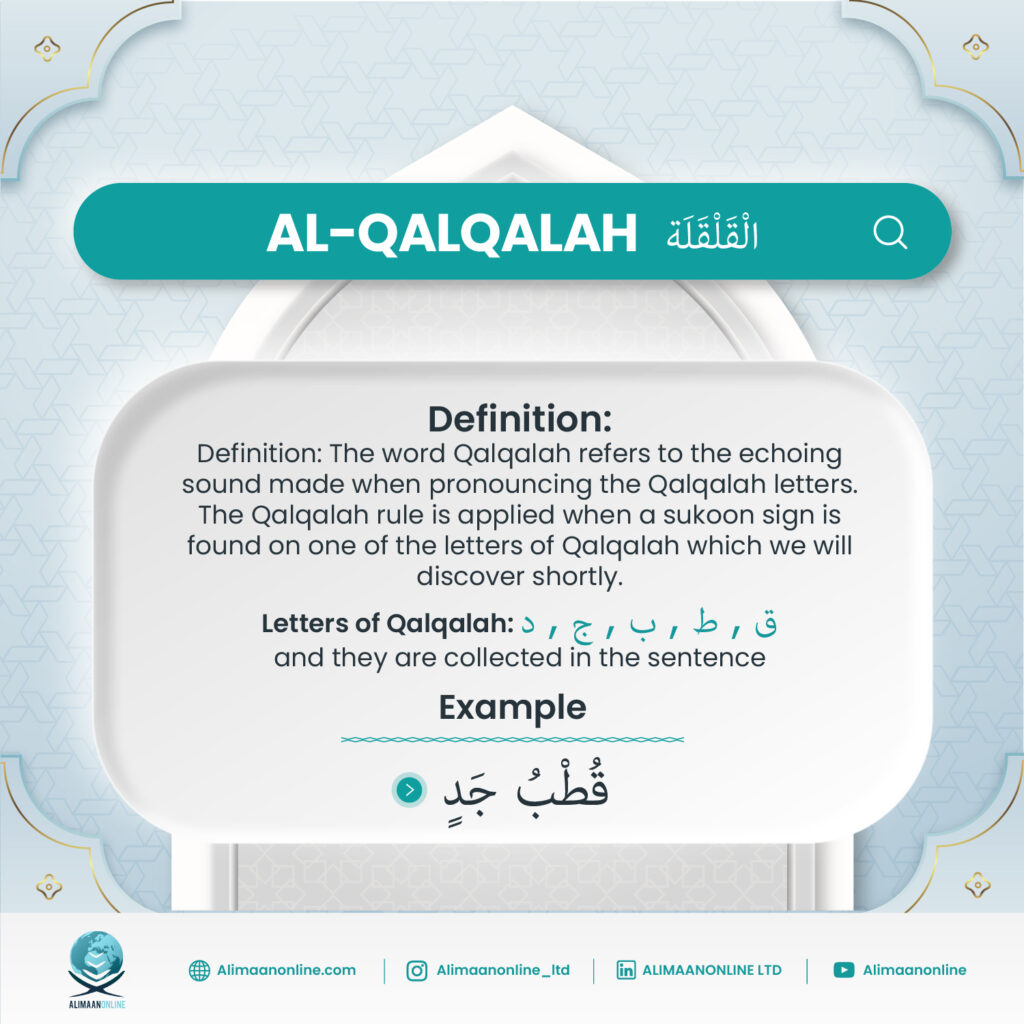When learning the art of Tajweed, one of the key concepts students encounter is Al-Qalqalah. Tajweed, the proper pronunciation of the letters when reciting the Quran, ensures that the beauty and meaning of the words are preserved. Al-Qalqalah plays an important role in enhancing the clarity of specific sounds, making the recitation more impactful. In this article, we will explore what Al-Qalqalah is, the types of Qalqalah, and its application in Quranic recitation.
What is Qalqalah?
Al-Qalqalah refers to the reverberation or echoing sound produced when certain letters are recited with a “sukoon” (a non-vowel stop). The sound causes a slight vibration or bounce in the vocal cords, creating a noticeable impact in the recitation. This rule of Tajweed is particularly important for non-Arabic speakers to ensure that the pronunciation of certain letters is clear and distinct. It prevents the reciter from making mistakes that could alter the meaning of the Quranic text.
The letters that fall under the rule of Al-Qalqalah are five: Qaaf (ق), Taa (ط), Baa (ب), Jeem (ج), and Daal (د). Collectively, they are remembered using the mnemonic “قُطْبُ جَدٍ” (Qutb Jad). These letters, when in a state of sukoon, will generate the Qalqalah sound.
Importance of Al-Qalqalah in Tajweed
Correct pronunciation is vital when reciting the Quran because mispronunciation can change the meaning of words. Al-Qalqalah provides a means to ensure clarity, particularly when certain letters are difficult to articulate without this bouncing effect. By mastering Qalqalah, a student of Tajweed improves their recitation, producing a more fluent and correct reading of the Quran.
The purpose of Al-Qalqalah is to:
- Emphasize and make the sound of the letter clearer, even if the letter is at the end of the word.
- Avoid blending the sound of Qalqalah letters with surrounding sounds, which can distort pronunciation.
Types of Qalqalah
There are two primary classifications of Al-Qalqalah, each with its own set of rules. Understanding these classifications is essential for proper Quranic recitation.
1. Qalqalah Sughra (Minor Qalqalah)
Qalqalah Sughra occurs when one of the Qalqalah letters appears in the middle of a word and carries a sukoon (a non-vowel pause) or at the end of a word we are not stopping on it. The echoing sound produced here is mild but still noticeable. It happens because the letter with the sukoon needs to be recited without elongation or any additional vocalization.
Example:
- The word “أَبْدَر” (Abdar) contains the letter Baa (ب) in the middle of the word with a sukoon. The slight bounce of the Baa here is an example of Qalqalah Sughra.
- (An-Naba: 8) وَخَلَقْنَـٰكُمْ أَزْوَٰجًۭا
This type of Qalqalah does not result in a strong bounce. Instead, it lightly emphasizes the letter, ensuring that the reciter can clearly distinguish the sukoon from the surrounding letters.
2. Qalqalah Wusta (Medium Qalqalah)
Qalqalah Kubra takes place when the Qalqalah letter appears at the end of a word, and the letter carries a sukoon due to stopping at the end of the word. The echo in this case is much more pronounced than in Qalqalah Sughra. The reason for this emphasis is that when reciting, the sound of the letter needs to reverberate clearly, and this bounce helps maintain the pronunciation even when there is a stop.
Example:
- The word “فَتَبْ” (Fatab) ends with the letter Baa (ب) with sukoon. When stopping on this word, the sound of Baa is echoed significantly, producing Qalqalah Kubra.
- (Al-Buruj: 20) وَٱللَّهُ مِن وَرَآئِهِم مُّحِيطٌۢ
- (Al-Masad: 2) مَآ أَغْنَىٰ عَنْهُ مَالُهُۥ وَمَا كَسَبَ
- (Al-Qiyamah: 29) وَٱلْتَفَّتِ ٱلسَّاقُ بِٱلسَّاقِ
- (Qaf: 8) تَبْصِرَةًۭ وَذِكْرَىٰ لِكُلِّ عَبْدٍۢ مُّنِيبٍۢ
This pronounced bounce can make the ending of the word stand out and ensures that the listener does not confuse the stopped letter with another sound.
3. Qalqalah Kubra (Major Qalqalah)
Although less commonly discussed, some scholars consider Qalqalah Akbar an additional category, referring to instances where the letter carrying the sukoon appears at the end of the word and is also associated with a shadda (doubling of the consonant sound). The echo in such cases is very strong, as both the sukoon and the doubling create a larger bounce effect.
Example:
- The word “حَقٌ” (Haqqun), when stopped at, contains the letter Qaaf (ق) with both sukoon and shadda. The sound of the Qaaf is emphasized strongly, producing Qalqalah Akbar.
- (ِAl-Masad: 1) تَبَّتْ يَدَآ أَبِى لَهَبٍۢ وَتَبَّ
- (Al-Baqarah: 189) …قُلْ هِىَ مَوَٰقِيتُ لِلنَّاسِ وَٱلْحَجِّ…
- (َQaf: 19) …وَجَآءَتْ سَكْرَةُ ٱلْمَوْتِ بِٱلْحَقِّ
This type is rare but requires careful attention to ensure the correct level of emphasis in recitation.
Application of Al-Qalqalah in Quranic Recitation
Understanding the different types of Al-Qalqalah is essential for those learning Tajweed. Applying these rules while reciting ensures that the letters are pronounced clearly, avoiding any distortion or blending of sounds. Let’s take a closer look at how Al-Qalqalah applies to common words in the Quran.
In the verse “وَاللّهُ غَالِبٌ عَلَى أَمْرِهِ” (Surah Yusuf, 12:21), the word غَالِبٌ (Ghalib) contains the letter Baa (ب) at the end with sukoon. When stopping here, the echo of the Baa creates a distinct sound, illustrating the application of Qalqalah Kubra.
Similarly, in the verse “فَسَيَكْفِيكَهُمُ اللّهُ وَهُوَ السَّمِيعُ الْعَلِيمُ” (Surah Al-Baqarah, 2:137), the word يكفيكهم (Yakfikum) contains the letter Qaaf (ق) with sukoon in the middle of the word. The light bouncing sound produced in this case is an example of Qalqalah Sughra.
When reciting the Quran, the proper application of Al-Qalqalah ensures that the listener clearly understands the intended meaning of the verses. Failing to apply Qalqalah correctly can lead to mistakes, as it can blur the pronunciation of critical letters.
Practical Steps to Mastering Al-Qalqalah
Mastering Al-Qalqalah requires practice and dedication. Here are a few practical steps to help students incorporate the rule into their recitation:
- Start with Single Letters
Begin by practicing each letter individually, especially the five Qalqalah letters. Focus on creating the bouncing sound when these letters have sukoon. - Practice Words with Qalqalah Letters
Move on to words containing the Qalqalah letters in different positions. Make sure to apply Qalqalah Sughra and Qalqalah Kubra appropriately based on the location of the sukoon. - Recite with Tajweed Teachers
Seek guidance from experienced Tajweed teachers who can provide real-time feedback on your pronunciation. They will correct your mistakes and help you identify where your Qalqalah needs improvement. - Use Audio Resources
Listen to recitations from well-known Qaris (reciters) who apply Al-Qalqalah correctly. Imitating their recitations will allow you to hear how the rule is applied in different contexts. - Practice Reciting the Quran
Apply what you’ve learned by regularly practicing Quranic recitation. Focus on verses where Qalqalah letters appear and pay attention to how your pronunciation improves over time.
The Significance of Al-Qalqalah in Enhancing Quran Recitation
Correct application of Al-Qalqalah brings several benefits to a student of Tajweed. The bounce or echoing sound makes the recitation clearer, ensuring that the listener understands the words correctly. It prevents confusion between similar-sounding letters, which can lead to mistakes in meaning.
Moreover, Al-Qalqalah adds a rhythmic quality to the recitation, enhancing its beauty. Tajweed rules like this one serve both practical and aesthetic purposes, making the recitation of the Quran a more fulfilling and spiritually enriching experience.
By mastering Al-Qalqalah, you are not only adhering to the correct pronunciation but also elevating the overall quality of your Quranic recitation. This rule, though simple in its concept, carries great significance in preserving the integrity of the Quran’s recitation across generations.
Conclusion
Al-Qalqalah is one of the essential rules of Tajweed, critical for ensuring the correct and beautiful recitation of the Quran. With five letters falling under this rule, it is important for students to understand the types of Qalqalah and how they apply to different Quranic words. Through practice and guidance, mastering Al-Qalqalah enhances both the clarity and rhythm of recitation, preserving the original meaning of the Quranic text.

